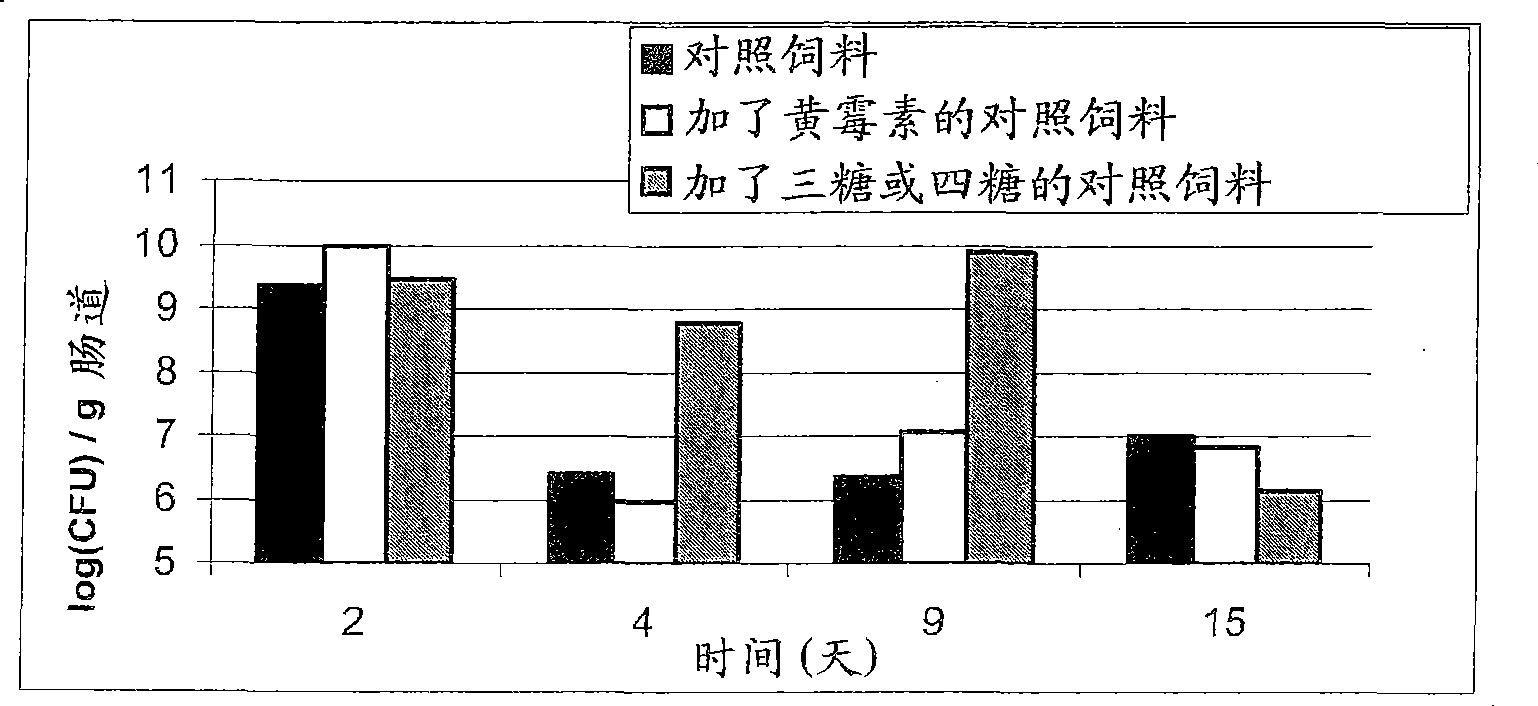Tri and tetra-oligo-saccharides suitable as agglutination agents for enteric pathogens
A technology of pathogens and agglutinating agents, which can be used in antiviral agents, metabolic diseases, and vector-borne diseases, and can solve problems such as heavy economic costs and high medical costs
- Summary
- Abstract
- Description
- Claims
- Application Information
AI Technical Summary
Problems solved by technology
Method used
Image
Examples
Embodiment 1
[0048] Example 1: Effects of trimannosaccharides and tetramannosaccharides on microbial ecology in the gastrointestinal tract of poultry system impact
[0049] 3 x 40 one-day-old chicks were provided with the following feeds: control feed, control feed supplemented with 3 ppm flavomycin, and control feed supplemented with 0.025% trimannosaccharide and / or tetramannooligosaccharide. The control feed was a mashed feed consisting of raw materials suitable as animal nutrition. Water and feed were provided ad libitum. Chicks were infested on day 2 with the contents of the cecum of three-week-old chicks (the period with the most severe gastrointestinal problems). Chicks were dissected at time intervals and the intestinal pathogen content in the small intestine was determined by plate counting on McFarland agar. The results are summarized in figure 1 middle.
[0050] from figure 1 It was clearly seen that trimannosaccharides and / or tetramannosaccharides had a positive effect ...
Embodiment 2
[0051] Example 2: Tri-galacturonic acid oligosaccharides and / or tetragalacturonic acid oligosaccharides (tri-and / or Effects of tetra-galacturonic-oligo-saccharide) on chick performance
[0052] The same experimental conditions as described in Experiment 1 were used. Daily growth and feed conversion were monitored after 13 days in this example. The results are summarized in Table 1.
[0053] Table 1: Effects of tetra-oligosaccharides on chick performance
[0054]
[0055] From Table 1 it can be concluded that the use of trigalacturonic acid oligosaccharides and / or tetragalacturonic acid oligosaccharides in this particular experiment gave similar results to those obtained with the traditional growth promoter (flavin). But the modes of action are not comparable (see Example 1).
Embodiment 3
[0056] Example 3: Trigalacturonic acid oligosaccharides and / or tetragalacturonic acid oligosaccharides on piglet performance Impact
[0057] At the beginning of the experiment, 5 piglets were housed in each pen. A feed trough (optionally assembled) was provided per pen for the administration of solid pellets. One drinking nipple per column. The temperature was started at 28°C until 10 days after weaning. The temperature was then lowered to 25°C. Administer a commercially available drug-free diet. Drug-free means that the piglets did not receive any therapeutic antibiotics before and during the experiment. The diet was administered in pellet form.
[0058] The diet is as follows:
[0059] -Co: Control diet
[0060] -Tr: Control diet + 0.125% mannooligosaccharide
[0061] The experimental design was as follows: 2 treatments (Co and Tr) × 16 parallel assays × 5 piglets.
[0062] At the beginning of the experiment, piglets (about 7 kg body weight) were distributed by ...
PUM
 Login to View More
Login to View More Abstract
Description
Claims
Application Information
 Login to View More
Login to View More - R&D
- Intellectual Property
- Life Sciences
- Materials
- Tech Scout
- Unparalleled Data Quality
- Higher Quality Content
- 60% Fewer Hallucinations
Browse by: Latest US Patents, China's latest patents, Technical Efficacy Thesaurus, Application Domain, Technology Topic, Popular Technical Reports.
© 2025 PatSnap. All rights reserved.Legal|Privacy policy|Modern Slavery Act Transparency Statement|Sitemap|About US| Contact US: help@patsnap.com



